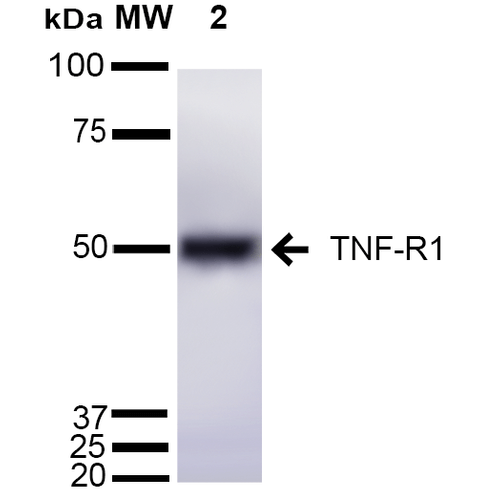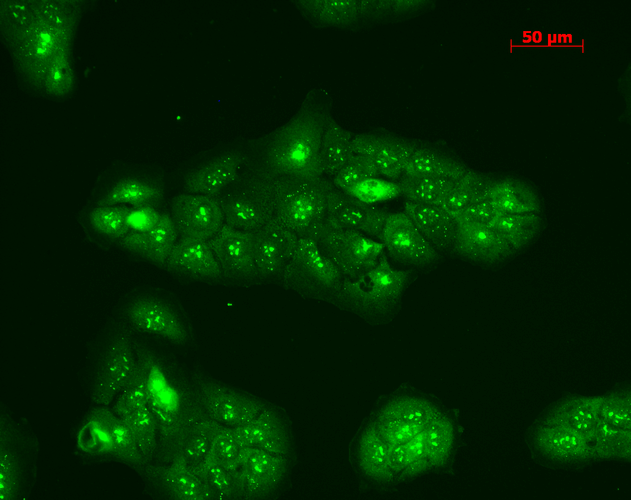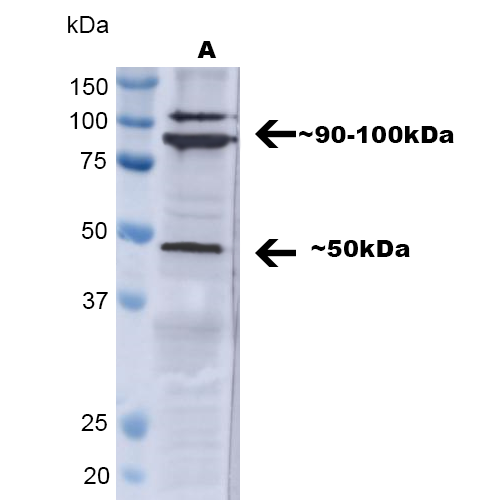SPC-170D-HRP
Scientist.com Supplier
TNF-R1 Antibody: HRP
Stressmarq Biosciences
Image

Image

Image

Image

Image

Image

DESCRIPTION
Rabbit Anti-Mouse TNF-R1 Polyclonal
DETAILS
- Target: TNFR1
- Gene Id: 7132
- Conjugate: HRP
- Immunogen: Peptide corresponding to AA 20-43 of the mouse TNF-R1 sequence, identical to rat and human over those residues
- References: 1. Kontermann R.E., et al. (2008) J Immunother. 31(3):225-34. 2. Hehlgans T. and Pfeffer K. (2005) Immunology. 115(1):1-20. 3. Al-Lamki S., et al. (2005) The Faseb Journal. 19:1638-1645.
- Swiss-prot: P19438
- Specificity: Detects ~55kDa. Other bands present may be the result of oligomerization, self-aggregation and/or cleavage of the TNF-R1 extracellular domain.
- Applications: WB | IHC | ICC/IF | IP
- Field of Use: Not for use in humans. Not for use in diagnostics or therapeutics. For in vitro research use only.
- Host Species: Rabbit
- Product Type: Polyclonal
- Purification: Peptide Affinity Purified
- Concentration: 1 mg/ml
- Research Areas: Cancer | Apoptosis | Cell Signaling | Cardiovascular System | Atherosclerosis
- Storage Buffer: PBS pH7.4, 50% glycerol, 0.09% sodium azide *Storage buffer may change when conjugated
- Alternative Names: Tumor necrosis factor receptor 1 Antibody, TNFR-1 Antibody, TNFRSF1A Antibody, TNFAR Antibody, TNFR1 Antibody
- Antibody Dilution: WB (1:1000), IHC (1:100), ICC/IF (1:100); optimal dilutions for assays should be determined by the user.
- Cite This Product: StressMarq Biosciences Cat# SPC-170D-HRP, RRID: AB_2703816
- Immunogen Species: Mouse
- Storage Temperature: Conjugated antibodies should be stored according to the product label
- Shipping Temperature: Blue Ice or 4ºC
- Cellular Localization: Cell Membrane | Golgi Apparatus | Golgi Apparatus Membrane
- Scientific Background: The Tumor Necrosis Factor Receptor (TNFR) also known as Cluster of differentiation (CD120) is a protein that belongs to the (TNF)/ (TNFR) superfamily. TNF interacts with two distinct receptors TNFR1 and TNFR2. These receptors share no homology on their cytoplasmic sequences(1,3).TNFR1 also known as p55/p60 is a high affinity receptor for TNF-α. The TNFR1 has an extracellular domain with variable numbers of cysteine-rich repeats. The functional properties of TNFR1 are targets in new therapies for osteoporosis, chronic inflammatory and autoimmune diseases (1, 2). The TNF-α/TNFR1 receptor complex is responsible for the recruitment and the subsequent activation of the caspase (aspartate-specific cysteine proteases) that regulate apoptosis.
- Certificate of Analysis: 1 µg/ml of SPC-170 was sufficient for detection of TNFR1 in 20 µg of Hela lysate by colorimetric immunoblot analysis using Goat anti-rabbit IgG:HRP as the secondary antibody.
- Species Reactivity Full Name: Human | Mouse | Rat | Bovine | Monkey | Dog | Rabbit
Equivalent Items
| ... Loading